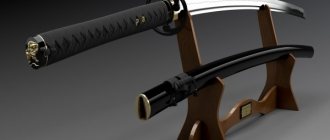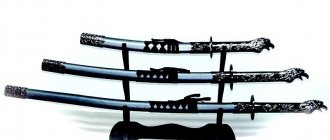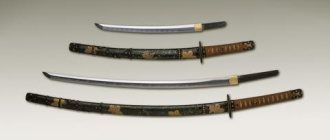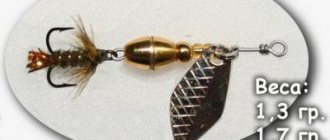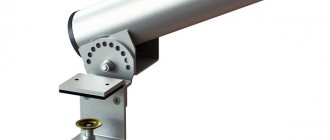As you know, males show interest in any type of weapon at any age. And if you don’t know what to give as an original gift to a man or what craft to make for your son for school, then we advise you to look at swords.
Today we will tell you how to make a paper katana with your own hands in a matter of minutes. This is a very simple but interesting model that even a child can make. There are two most common manufacturing methods, which we will consider in more detail today.
Manufacturing process
So, let's look at how to make a katana out of paper. The first thing you need to do is prepare five rectangles for the blade. It is better to cut them from durable cardboard. Determine the length yourself, but the width in this craft is fixed - six centimeters. In order for you to get a fairly strong blade, you should evenly and carefully lay the strips of cardboard one on top of the other. We will fix the workpieces with PVA glue. Then we place some weight on top and leave the blade to dry for two to three hours.
For the handle of the sword we use a tube of foil or baking paper. It should be thoroughly painted with silver paint. Let the paint dry.
We prepare the guard. This is a circle that protects the hand from contact with the blade. The guard can be cut from cardboard or made from plain paper. If you make from paper, you will need about ten layers, which are carefully coated with glue. How to make a katana sword out of paper to make it more realistic? Try carefully cutting out a beautiful design on the guard. It is better to do this with a sharp stationery knife. If the craft is done by a child, then it is recommended to seek the help of parents in this matter.
Now all that remains is to connect the pieces. We insert a blade into the hole in the tube and place a guard between them. If the need arises, we adjust the dimensions and angles using stationery scissors.
So, we told you how to make a katana out of paper. The scheme is simple and clear. Now all that remains is to use your imagination and paint the product with acrylic paints.
Necessary materials
- Scissors.
- Paper.
That's all the materials that will be needed for such a craft. We decide on the size. The A4 format will allow you to make a small sword, but if you take A3 or A2, you will get a rather impressive and formidable weapon.
This option will be performed using the classical technique - origami. The katana will not be a craft made from several pieces, but one sheet folded in a certain way.
The first thing you need to do is fold the sheet diagonally and cut off the excess to make an even square. We bend the corners on both sides so that they meet in the center. Now we unfold the sheet and make folds on the long side. Next, without turning the sheet over, roll up the short sides of the square. You should end up with a long rectangle with curved corners.
Now we form the handle. To do this, you need to bend one corner and lay it three-quarters the length of the entire rectangle. Now we fold it again, but the length will be even shorter. When you unfold and turn the product over, in this place it should look like an accordion made of paper.
We mentally divide the strip into three parts and wrap the two outer parts towards the center. Now we bend the part where the accordion was to the side. It turns out to be a handle. All that remains is to add a sharp angle to the sword where the piercing pike will be.
We told you only about two ways to make a katana out of paper. But there are many more of them. If your product turns out to be too fragile, then you can always strengthen it with tape. Several layers - and the origami craft will be strong and reliable.
The production of a katana is divided into a large number of stages and can take several months. First, Tamahagane steel pieces are placed next to each other, covered with a clay solution and covered with ash. This allows you to remove slag from the steel, which during melting will be removed from the metal and will be absorbed by clay and
ash. Next, the metal pieces are heated to combine them. After this, hammer forging occurs: the created rod is flattened and folded, then flattened again and folded again - thus doubling the number of layers (with 10 folds, 1024 layers are obtained, with 20 - 1048576) As a result, the carbon is evenly located in the rod, which allows make sure that the strength of the blade is the same over the entire surface.
Katana manufacturing technology
Then it is necessary to put softer steel into the workpiece so that the blade does not break under severe dynamic loads. During forging, which takes several days, the workpiece is lengthened and by joining strips of different hardnesses, the structure of the blade and its original shape are formed. Next, a series of liquid clay is applied to prevent oxidation and overheating. A pattern is formed on the cutting edge - the jamon hardening line.
This line becomes visible when polishing the sword. Hamon is a distinctive sign of the master; by it it is possible to find out who created the katana. Then the sword is hardened: it heats up to a temperature of approximately 840-850 ° C and immediately cools, as a result of which the katana takes on extraordinary hardness. In addition, during the hardening process, the blade bends on its own, while the magnitude and shape of the deflection are specific and depend on the cooling method. Then the blade is given a finished look, sharpened and polished using stones of different grain sizes. Moreover, the master strives to achieve completely flat surfaces and clear angles of edges between planes. Sometimes on parts of the katana that have not been hardened, decorative engraving is created, usually on the theme of Buddhism. After polishing and decorating the handle, the katana can be used.
We present our developments in videos of fencing with katanas, machetes and knives. After watching our films, you may discover some new aspects of history, weapons, and culture. This section presents fencing techniques, the technique of their implementation, and the technique of movement during execution. Knife fighting videos on techniques and techniques will delight anyone who is seriously involved in knife fighting. We pay a lot of attention to technique, all our lessons are designed so that you can watch not just the quick execution of techniques, but understand how this technique is performed. For this reason, the show is often performed in a slightly slower format, which of course does not negate its fast execution during production. Separately, there are sparrings - videos of knife fights. Here you can see the real application of the techniques shown earlier in other videos.
Standing apart are small feature films related to weapons, the history of samurai, the making of samurai swords, traditions, old photographs and much more. We sincerely hope you enjoy these films.
Another aspect of our knife fight videos is testing strikes and weapons on real flesh - on pieces of meat - on pork knuckles, pork side. This is necessary to understand HOW a blow is delivered with one or another weapon, what passes and what does not, and often commonly used myths are dispelled during such testing. We don't want to be like Discovery or Cold Steel, not at all, but we like their format and we adopted it for ourselves.
We sincerely hope our videos of knife fighting, techniques with a katana and machete will not disappoint you and you will find something useful for yourself in them.
Tip 5: How to sharpen a katana
You will need
Instructions
1. Take the sword in your hands and mentally divide the blade into three parts. The upper part will require particularly sharp sharpening (it will cut), the middle one will require sharpening at a huge angle (it will be subject to load upon impact) and, finally, the lower part, which is closest to the guard, will be sharpened minimally (no load will actually be applied to it) . Mark these parts with a marker.
2. First, sharpen the blade minimally. To do this, turn on the electric sander, put on safety glasses, wait about one minute until it spins completely, and bring the tip of the sword perpendicular to it. With a light movement, without pressing the blade tightly against the emery disk, move the sword from right to left, then turn it over and draw it from left to right. Repeat the procedure until you can clearly feel a sharp angle on the cutting edge with your finger. The same result can be achieved by running a sharpening stone along the blade, but this will take much more time and effort.
3. Now sharpen the upper part of the blade. Again, bring the katana to the sandpaper and place the blade flat on the disc. Angle it so that the cutting edge lightly touches the rotating disk. Using movements from left to right and right to left, move the blade from the tip to the mark of its middle part. This will reduce the sharpening angle.
5. Now bring the sword to the required sharpness with sharpening stones. First, run them evenly along each length of the blade in order to remove any permissible irregularities. After this, purposefully sharpen each part individually with short, sharp movements, starting from the bottom.
Note! The smaller the sharpening angle, the lower the strength of the blade. Cutting hard materials requires large cutting angles, while cutting soft materials requires much smaller cutting angles.
Do-it-yourself katana sharpening
Sharpening a katana with your own hands is not nearly as difficult as it might seem.
In ancient times in Japan there were special craftsmen who spent weeks sharpening on water stones. There have always been very few such masters and their services were incredibly expensive. Not only was the cutting edge itself processed, but the blade itself was polished - all this was part of the understanding of sharpening a katana. Today, sharpening refers to processing only the cutting edge of the blade and bringing it to a razor-sharp state.
Contrary to popular belief, this is quite easy to do today at home with your own hands. The standard cost of a one-time blade sharpening is from 1,500 rubles. But what can you do yourself at home - how to sharpen a blade so as not to spoil it? Well, first of all, you need to understand why you are sharpening your katana. For chopping makivar from rice straws is one thing, for chopping not too thick tree trunks is another thing, for chopping all sorts of meat items such as sausages is something else.
Let's do real sharpening of a katana at home with our own hands.
The weapon used was a Chinese katana, hardness up to 52 - 54 units, monosteel, spring, nothing unusual, a fairly cheap sample. For sharpening we took musat, a fiskars type sharpening device with rotating stones, and a bottle of oil.
First, all small roughness and burrs are removed from a completely working blade, which has just been used to chop a lot of plastic bottles using musat. Then, using a Fiskars type sharpening device, the knurling edge of the katana is sharpened.
The result is checked on a piece of paper. As a rule, one pass is not enough for normal paper cutting and razor sharpness, and therefore the blade is lubricated with oil and rolled back into sharpening devices. Taking your time, a katana blade can be sharpened in three to five steps.
As you can see from the video, a sharpened katana cuts paper like a razor.
Evgenia Smirnova
To send light into the depths of the human heart - this is the purpose of the artist
Content
This question is asked by many parents of mischievous boys. All the kids play various role-playing games or imitate their favorite ninja characters from cartoon series. There are many toys, swords, and laser weapons on store shelves, but it is much nicer for a son to receive a gift that mom or dad made with their own hands.
Communities › Do It Yourself › Blog › Do-it-yourself katana made of wood and epoxy resin.
Hi all. According to the good old tradition, a link to a video with a more detailed crafting process is at the end of the post.
After playing Cyberpunk 2077 enough, I decided that I definitely needed some kind of unusual katana. It’s purely decorative, I didn’t intend to cut anything with it, and there’s no forge nearby, so the option of making it out of steel immediately disappeared and I decided that I’d make it out of plywood and epoxy resin.
I downloaded the template from the Internet and adjusted it to the required size, usually katanas are 85-105 cm long, I plan to make mine 99 cm. I printed the template onto several A4 sheets, glued it and glued it on the back side with thick paper to make the template more rigid.
During crafting, I tried a couple of options, for example, the combination of epoxy and a burnt wooden blank did not look bad, but the strength left much to be desired and the blank broke during sanding.
Plywood gave more strength and, in theory, it could be burned, but I didn’t take any risks, I cut it to shape, sharpened it and cut out a pattern called jamon. It will be right on the border of plywood and epoxy and in general it should not look bad.
The katana is planned to be black and red, so the end was coated with stain, dried, a paper formwork was put on, laminated with tape, and filled with epoxy resin.
When the resin had dried, I sharpened the blade and polished it with sandpaper from 80 to 2500 grit with water, so that the dust would not fly away and the sandpaper would not clog. The wooden part was covered with Ebony wood stain.
Tsubu did the same with resin, pouring it into a ginger jar) He poured red epoxy around the edges and clear epoxy into the center.
The handle, or rather the menuki, was made from two pieces of plywood, in which I cut out a groove for the blade and glued everything together, treated it with a petal disk and covered it with gray leatherette, which was painted with red acrylic paint.
The braid was made from black perforated leatherette, running it onto strips 7 mm wide. In total, you need a little more than 3 meters, but I didn’t have such a length of strips, so I took 2 x 1.5 meters and glued them to the handle, after which I began to weave according to the standard pattern, turning the leatherette strip 360 degrees on each weaving turn .
How to make a katana out of paper - diagrams with photos
This process is not at all difficult, the main thing is to start. With step-by-step instructions, everyone will figure out how to make a katana out of paper. Involve your child so that he doesn’t get bored at this time, or prepare a pleasant surprise for him in the evening. You can make a Japanese sword with your own hands from plain paper, cardboard, or use the origami technique.
DIY paper katana using origami technique
If you are wondering how to make an origami sword out of paper, follow the instructions:
- Take half of a regular landscape sheet. It is advisable to use colored paper in light shades.
- Prepare similar parts of the sheets, but in a dark color - this will be the handle and sheath of the katana. Apply the resulting blade to one, mark the length of the future handle and separate the dark-colored sheet.
- Make a sheath out of most of it. Bend the edge that will be located at the tip inward, the opposite, on the contrary, outward.
- Wrap the blade in a dark sheet and secure the sheath with glue.
- The remaining small leaf is the handle. Insert its edges into the slit of the blade and wrap it around. In order to practically understand how to make a sword out of paper and please your child, it’s time to glue the two halves of the finished Japanese sword.
How to make a sword from cardboard
To prepare a pleasant surprise for your son or husband, you need to know how to make a katana out of paper. To do this you will need:
- cardboard (you can use regular boxes);
- PVA glue);
- knife (stationery);
- glue (carpentry);
- paint of different colors - silver, black, red, blue.
If you still have no idea how to make a sword out of cardboard, know that it should be at least 60 cm in length. This should be used as a starting point when calculating the size of parts. Toy weapons, just like in Japan, are easy to make:
- From cardboard you need to cut five rectangles 50-70 millimeters wide. In this case, take into account how the wavy stripes are located on the material. On two of them they should be located vertically, on three – horizontally. Next, you need to stack them on top of each other, starting with those with stripes in the vertical direction.
- Glue the pieces together. For a stronger connection, you should place the workpiece under a heavy object (then the sword will become dense, like a wooden block).
- When the workpiece dries, you need to draw a drawing in the shape of a weapon and cut it out of cardboard.
- Apply glue (carpenter's glue) to the sidewalls where the corrugation is visible. It is better to pour it in two layers, then let it dry for about 10-12 hours.
- The last stage before the paper katana is ready is painting. We cover the blade with silver paint, make the handle black, and paint the invented design on it with the remaining colors.
- If desired, coat the blade with clay and sand before painting - then the sword will be even denser.
DIY samurai weapon made of paper - Deadpool's katana
Before you make a paper sword, you need to prepare:
- cardboard;
- compass;
- marker (black);
- paper tubes (two thick, two thinner);
- scissors;
- braid.
The easiest way to make a katana out of paper:
- We make 3 circles on the cardboard, one equal to the diameter of the smallest tube, the second equal to the diameter of the other. The last circle will be 1-1.5 cm larger than the second. Trim off the excess cardboard and cut out a small circle using a utility knife.
- We flatten the smaller tubes, get two rectangular plates, and fasten them with tape. This will be the blade. We perform similar actions with large tubes that will serve as sheaths.
- We make the tip of the blade: we draw what it will be, cut it off, and seal it with tape.
- We insert two tubes inside the blade, adding volume.
- To make the katana look like steel, wrap the blade in foil several times and secure it with office glue or tape.
- We make a handle: we fix the main tube on which it will be held with glue. We color the plate that will serve as a tsuba with a black marker. We wrap the tube-handle with tape and secure the edges with tape. We put on the tsuba, then the handle.
- We paint over the entire surface of the scabbard with a bright black marker.
They have survived to this day and do not lose popularity. Since ancient times, the katana has been made from damask steel - “Anosov” steel, but fighting with such a tool is dangerous, so we’ll put the original samurai weapon aside for now, let it decorate the interior.
If you decide to study the ancient art of the samurai, then a bokken, a wooden analogue of a blade, is perfect as a training weapon. “How to make a katana from wood?” - Many people asked themselves this question, but only a small number of samurai mastered the wooden bokken technique.
How to make a katana at home
Katana is a long, slightly curved two-handed sword, first invented and made in Japan. It was one of the samurai's weapons. Later in Quentin Tarantino's Kill Bill, the katana began to excite many people. How to make a katana ?
You will need
- An anvil, iron sand (special black sand from the coast of Japan that is used to smelt iron), hammer, smelter, charcoal, forge, sandstone powder, water, clay, rice straw, and grinding and polishing tools to process the resulting steel. If you were able to discover all this, then let’s proceed to making the sword itself.
Instructions
1. Immerse charcoal, light it, place sand in the smelter and at a temperature of 1500 degrees, smelt approximately four kilograms of steel. Divide the resulting metal into a little - and high-carbon iron. Low-carbon iron is gray-black in color. Place small and large pieces of charcoal at the bottom of the forge, then light it. After this, place high-carbon iron in the forge and also add a little charcoal. 2. After this, spread rice straw ash and pre-crushed charcoal on the bottom of the furnace, place a layer of high carbon steel and fill it all with charcoal. After this, begin to rapidly pump the bellows until only one piece of iron remains in the forge. Carefully remove the pieces of steel and begin to forge them into flat sheets. Make sure that they are no more than five millimeters thick. Divide iron into high- and low-carbon. 3. Place pieces of high-carbon steel on a steel blank with a handle, wrap it in paper and apply clay. After this, put it all in the forge and fill it with coal. Heat for approximately 30 minutes until white. Take out the resulting block, place it on the anvil and hit it several times with a hammer. After that, put it back into the forge, heat it up perfectly and hit it again with a hammer several times. Repeat this procedure five to six times. 4. You have obtained iron, which is called “kawagane”. Take the low-carbon iron that you have previously set aside, make a bar out of it by forging, and then roll and hammer it another 9-10 times. Now you have received the Shingane iron. 5. The next step is to prepare the blade. Split the block and forge it into a rectangular plate. By stretching the plate perpendicular to the length, you will give the blade the desired shape. File the shank of the blade. Complete the process of making a katana as follows. Make a handle from a couple of blocks of wood, which you first wrap with leather and then with cotton cord.
The aura that surrounds the mythical samurai sword, the katana, has maintained interest and admiration for this type of weapon for hundreds of years. Katana is a strong, light and elastic sword. It becomes this way due to the special materials from which it is forged, the special forging technique and, according to legend, the true heartfelt attitude of the master.
You will need
- Ferrous sand
- Smelter
- Horn
- Hammer
- Anvil
- Charcoal
- Rice straw
- Clay
- Sandstone Powder
- Water
- Tools for grinding and polishing steel
Instructions
1. In order to forge the right katana, you need to stock up on special “black sand” from the Japanese coast. These are ferrous sands from which you will have to smelt tamahagane - traditional Japanese iron used for forging samurai swords. 2. Load ore sand into the smelter - tatara - and smelt about 4 kilograms of steel using charcoal. The temperature in the melting furnace should reach 1,500 degrees Celsius. 3. Sort the iron into low-carbon and high-carbon. High carbon tamahagane is heavier, clear silver in color. Low-carbon - rougher, gray-black in color. 4. Cover the bottom of the forge with crushed charcoal, add huge chunks of coal and light them. Lay down a layer of mild steel and add another layer of charcoal. Wait until the iron sinks to the bottom of the forge. 5. Cover the bottom of the furnace with rice straw ash mixed with powdered charcoal, lay a layer of high-carbon steel in a heap, and cover it with charcoal on top. Start actively pumping the bellows. Wait until only iron remains in the forge. 6. Take the pieces of tamahagane and begin to forge them into flat sheets half a centimeter thick. Cool the sheets in water and break them into 2cm square slabs. Sort the iron into high-carbon and low-carbon. 7. Take selected pieces of high carbon steel and place them on a steel plate with a handle. Wrap in paper and coat with clay. Place in the blacksmith's forge. Pour in charcoal and heat for at least thirty minutes until clear yellow or white. 8. Remove the block from the forge, place it on the anvil and hammer it down. Place back into the forge, heat and forge. Repeat this cycle several times. 9. When your block is ready, make a dent in it with a chisel and roll it towards you. Reheat and hammer until the top and bottom halves are fused and the block returns to its original length. Repeat this cycle six times. 10. Before continuing forging, cut the block into four equal parts. Stack them one on top of the other and weld them together by heating and forging. Repeat rolling, heating and forging six more times. You now have kawagane iron. 11. Take the low-carbon iron that has been set aside, forge it into a bar, and then roll and hammer it ten more times. You have got “singane” or core iron. 12. Forge a flat plate 40 centimeters long from kawagane, roll it in the shape of the letter U. Place a shingane block inside this plate. Heat the workpiece in the forge until it turns clear yellow and begin to bind. Achieve complete welding of the plates to each other. 13. Make a blank for the blade by heating a block in a forge and forging it into a rectangular blank. Shape the blade by stretching the blank perpendicular to its length. Form the cutting edge, tip, side ribs and butt. 14. With the support of a scraper knife, process the surface of the sword. Use a file to file the butt and cutting edge. Using a carborundum stone, pre-grind each blade. 15. Prepare a sticky clay mixture from clay, crushed charcoal and sandstone powder in equal proportions. Dilute with water and apply to the cutting edge with a spatula. A thick layer along the butt and on the side surfaces and a very thin layer along the very edge. Wait until the clay hardens. Heat the blade in a forge to 700 degrees Celsius and cool it in a container of water. 16. Adjust the curve of the blade and polish it. 17. Use a file to file the shank of the blade. 18. Finish the production of the katana by making a handle from 2 halves of wood, first wrapped in leather and then with cotton cord. Video on the topic Useful advice You can learn the art of making an ordinary katana in person from a genuine master. There are a lot of subtleties and secrets that are passed on only from teacher to student.
A real katana, being a samurai weapon, is made from certain types of iron, forged in several layers. But modern katanas, as usual, are forged from spring steel. Consequently, sharpening Japanese remake swords has its own characteristics. You will need
- – katana;
- – stones for sharpening;
- – electric emery;
- – marker;
- - protective glasses.
Instructions
1. Take the sword in your hands and mentally divide the blade into three parts. The upper part will require particularly sharp sharpening (it will cut), the middle one will require sharpening at a huge angle (it will be subject to load upon impact) and, finally, the lower part, which is closest to the guard, will be sharpened minimally (no load will actually be applied to it) . Mark these parts with a marker. 2. First, sharpen the blade minimally. To do this, turn on the electric sander, put on safety glasses, wait about one minute until it spins completely, and bring the tip of the sword perpendicular to it. With a light movement, without pressing the blade tightly against the emery disk, move the sword from right to left, then turn it over and draw it from left to right. Repeat the procedure until you can clearly feel a sharp angle on the cutting edge with your finger. The same result can be achieved by running a sharpening stone along the blade, but this will take much more time and effort. 3. Now sharpen the upper part of the blade. Again, bring the katana to the sandpaper and place the blade flat on the disc. Angle it so that the cutting edge lightly touches the rotating disk. Using movements from left to right and right to left, move the blade from the tip to the mark of its middle part. This will reduce the sharpening angle. 4. Sharpen the middle part of the blade. The sharpening angle should be 40-45°. Move the blade along the sandpaper, pressing it tightly against it - from the middle part mark to the bottom mark using the method described above, until you achieve the desired sharpening angle. Do the same with the bottom of the blade. Here the sharpness of the sharpening is not so significant, therefore an angle of 50° will be enough (but no one is stopping you from making it smaller). Sharpening the lower part should end 2-3 cm from the guard (it will be difficult to sharpen further, but the guard can be easily peeled off). 5. Now bring the sword to the required sharpness with sharpening stones. First, run them evenly along each length of the blade in order to remove any permissible irregularities. After this, purposefully sharpen each part individually with short, sharp movements, starting from the bottom. Note! The smaller the sharpening angle, the lower the strength of the blade. Cutting hard materials requires huge cutting angles, but cutting soft materials requires much smaller cutting angles. Helpful advice After chopping swords, your blade will inevitably become jagged (to preserve it, it is better to fight off enemy weapons with the flat side of the blade), so repeat the sharpening procedure with whetstones after the entire battle or once a week.
A katana is a long, two-handed, curved sword with one sharp edge. Along with the short wakizashi sword and the auxiliary tanto dagger, it was part of the core set of weapons of the Japanese samurai. The katana was the soul of a warrior, a jewel, a family heirloom and even a philosophy. Nowadays, Japanese culture and martial arts are extremely famous in Russia, and therefore samurai swords are in great demand. Knowing to positively prefer a katana is also an art that needs to be learned.
Instructions
1. Decide for what purpose you want to purchase a katana . The size of the sword, equipment and even material will depend on this. 2. If you need a sword for training, purchase a bokken - a wooden model of a katana. The bokken must withstand powerful blows; therefore, it is made from hard wood (beech, oak, hornbeam) and impregnated with varnish or resin to increase density. With intense training, the sword will last 1-2 years. In Japan, bokken are treated with about the same respect as real katanas. 3. If you choose to train with a real sword, when choosing a katana, pay primary attention not to decor, but to size and shape. Take the sword in your hands: holding it should be comfortable and glorious. The length of the katana varies from 95 to 120 cm. In order to positively select the length of the sword for yourself, stand straight and grab it by the base of the blade near the round guard (tsuba). The tip of the blade should actually touch the floor. The length of the katana (tsuka) handle should be approximately three of your fists (about 30 cm on average). 4. When purchasing a weapon as a gift, as an interior decoration, give preference to a set of 2 swords (katana and wakizashi) or 3 (katana, wakizashi and tanto). It will look more significant and rich. Unlike European sabers, dirks and swords, Japanese katanas do not hang on the wall, so you will certainly purchase a special stand. 5. In order for the katana to take its rightful place in the interior, take care of the accessories. A distinctive feature of samurai swords is the possibility of disassembling them into combined parts. Due to the fact that the handle was usually made of wood and covered with leather or fabric, it quickly wore out and needed to be replaced. When choosing a katana , purchase an additional set for its frame (soroi-mono). It includes the tsuba (guard), menuki (handle decorations), kashira and futi (handle head and sleeve). 6. Remember that a samurai sword, like any other weapon, must be properly cared for. Be sure to purchase a special katana care kit. It includes natural stone powder for polishing, rice paper for cleaning, oil for lubricating the blade, and a mekugitsuchi, a tool for removing the wooden nails (mekugi) that secure the handle. Video on the topic Please note! If you want to buy a katana as a gift, not as a piece of furniture, but for martial arts practice, be sure to come to the store together with the future owner. Of course, there will be no surprise, but only the warrior himself will be able to determine whether the sword has a positive length and whether it will be convenient to work with it.
The Japanese katana sword is created over several months. The process is so difficult because the weapon must be sharp, strong and not brittle at the same time. To achieve this, craftsmen combine several types of metal in one blade. If you decide to draw a katana and want the drawing to be believable, consider the design features of this weapon.
You will need
- - pencil;
- - paper;
- – eraser;
- – paints/colored pencils.
Instructions
1. Draw a straight line. It will serve as the basis for the essay. If there are other objects or people in the picture besides the katana, determine their proportional relationship. Consider the length of the weapon - about 70-100 cm. 2. Divide the line into three equal parts. The upper segment indicates the length of the handle. Since the sword should be curved, slightly bend the drawn segment. The most “convex” point is located in the middle of the segment. 3. Mark the width of the katana. The width of the blade is approximately 30 times less than the overall length of the weapon. Make the handle a little wider than the blade. The tip of the blade should be beveled - “cut” the end of the sword at an angle of 45°. 4. Draw a guard at the border of the handle and blade. This is a metal attachment that protects the warrior's hand. Its diameter is on average 8 cm, and its thickness is 5 mm. You can choose the shape of the guard as you wish - it can be round, oval, quadrangular, polygonal, divided into parts. On the surface of this part of the katana it is possible to depict carvings or edging with non-ferrous metals. The guard is secured at the top and bottom with washers - draw them in the form of thin stripes. 5. Draw a stripe under and above the guard, make the top one tighter. These are couplings made of brass or bronze. 6. Remove the auxiliary construction lines and draw in detail the surface of all parts of the katana. You can make a watercolor background in advance and add pencil strokes to the dried paint. 7. The handle of the katana should be covered with leather. It is wrapped with ribbon on top. Invent a winding pattern or copy it from a photograph of an authentic weapon. You can add voluminous decorative elements between the turns of braid. Closer to the guard, draw a small pin that attaches the handle to the blade. 8. The katana blade can be made of one or more metals. The highest quality specimens are made of strong metal around the edges and more soft metal in the center of the blade. Draw the boundaries of these “layers”. While angling the blade, determine where the light source is and mark the highlights and shadows on the blade. 9. Draw the sheath for the katana in the form of a curved rectangle. In its upper part there should be a cord threaded into a loop.
Japanese weapons have long ago become famous all over the world. The long katana sword was even included in the Russian weapons state standards of edged weapons, where it was called a two-handed saber. A well-made katana appears monolithic, but in fact it can be disassembled. For example, it is recommended to disassemble it during transportation. There may also be a need to replace the handle. In addition, collectors are often allowed to see individual parts of this sword.
You will need
- – small hammer;
- – brass tongue:
- - gloves.
Instructions
1. The sheath is an inseparable part of the katana. In Japan, they were most often made from stingray skin. Now this material is used mainly in expensive models, and for the rest, sheaths are made from any kind of leather, including unnatural ones. sheathed katana This fashion arose in the 17th century and has survived to this day. Before removing the hilt, remove the sword from its sheath. 2. The tsuka (handle) of a classy katana is attached with the help of one or several pins - mekugi (in another transliteration - mekugi). The pins were usually made of bamboo and were not glued in place. Now mekugs are also made from other materials, and in inexpensive models, the handle parts are repeatedly glued on. Therefore, when buying a katana, you need to ask the seller to disassemble it. Wear gloves before you begin removing the handle. You can get by with one - on the hand with which you will hold the blade. 3. Place the katana on a horizontal surface. If you are not very sure that the pins will come out easily, you can carefully fix the sword in a vice. But usually this is not done. Place the point of the brass tongue against the pin. Carefully hit the head of the brass piece with a hammer to knock it out. That's right, knock out the rest of the mekugi in the same way. It’s rare that there are more than 3 pins; traditionally, one or two are enough. Set the mekugi aside or in a small box so they don’t get lost. Tsuka was traditionally made from magnolia wood. Nowadays different plastics are often used. 4. With a gloved hand, grasp the sword by the blade next to the guard. Pull the handle firmly. It must be removed from the shank, the one called nakago, with some effort. Remove the footy coupling located between the handle and the guard. 5. The next part that needs to be removed from the knife is the seppa, an original washer that makes the connection stronger and prevents the handle from splitting. It’s true that the same seppa is on the other side of the guard. 6. Remove the guard, which is called a tsuba on a katana. After this, it remains to remove one more washer and another coupling, which is called habaki. Occasionally you can disassemble the handle by removing some decorative elements from it. But on modern working swords these decorations are traditionally not removed. Useful advice The short Japanese sword can be disassembled in a similar way and with the help of the same simple devices. The hammer does not have to be very huge. They do not need to knock powerfully; brass is a fairly soft material, and the tongue can become deformed. Katana care items can be purchased in the same store as the sword itself.
Charcoal is one of the products of wood combustion. A black porous substance that consists of carbon and hydrogen with a small number of mineral impurities in the form of carbonates and oxides of various metals.
You will need
- – wood for transformation into coal
- – wood for the fire
- – steel container
- – scoop
Instructions
1. Charcoal is obtained by thermal decomposition of wood without air flow. This process is called pyrolysis. Depending on the combustion conditions, a product with different properties is formed. The main parameter affecting the quality of coal is the pyrolysis temperature. 2. When wood is charred, moisture and oxygen are removed from it, leaving only flammable substances - carbon and hydrogen. The pyrometric parameters of the resulting product increase in comparison with the initial material. To purchase coal, wood must be heated slowly, and the temperature of the process should be about 400°C. Rapid heating to high temperatures will lead to the formation of tar and volatile combustion products. 3. You can also make charcoal at home by building an analogue of a charcoal stove. A steel barrel with a sealed lid is suitable for this. Prepare a place and wood for the fire, as well as wood prepared for transformation into coal. Place the barrel on a stand, say, on stones or bricks. Fill your makeshift charcoal kiln with wood, pre-cut into small pieces. Close the lid tightly. Provide small openings for flammable gases to escape. Light a fire under the barrel. 4. After a few hours, when gases stop coming out of the holes, heating can be stopped. But the barrel should not be opened until the resulting coal has completely cooled without access to air. Otherwise, the combustion process in air may resume and the coal will burn out completely. 5. You can easily burn wood in a stove or in a fire until red coals form. After this, scoop the coals into an iron container, close it tightly and leave without air flow until it cools completely. Note! Attention! When working, take precautions! Wear gloves and good lighting. Helpful Hint Do not start making a katana until you have all the necessary components ready.
Features of a wooden katana
Japanese culture is rich in traditions. Training swords have been used in samurai art for hundreds of years. There are many schools of martial arts in the East. Depending on belonging to a particular school, the bokken sword has its own parameters and name. For example, to make a Bokuto bokken, white wood is used. The length of such a blade is 102 cm, and the weight varies between 580-620 grams. As for the Keishi-Ryu bokken, such a weapon is heavier and, with its length of 102 cm, weighs 730 grams.
A bokken is a replica of a katana, made of wood, which has been used since time immemorial to learn the samurai craft. Having learned how to make a katana from wood, you will be surprised, because this process is not labor-intensive.
The shape of the bokken completely duplicates the shape of the katana, but due to the material used to produce the weapon, it weighs less. How to make a katana from wood with your own hands and get a quality product? Choose the right material. The following types of wood are mainly used to make bokken:
- oak: white, red, black, brown;
- hornbeam.
The blade of a wooden bokken, like a real katana, is beveled at an angle of 45 degrees at the end, and the profile of the blade has a flattened oval or round shape. It depends on the type of weapon.
A distinctive feature of samurai bokken is the absence of a guard, a transverse pad that protects the hand from the enemy’s weapon sliding along the blade. A shallow cut is made along the entire length - “hi”, thanks to which the bokken makes a characteristic whistling sound when struck.
Step by step guide
- To get started you will need a drawing. You can draw a rough drawing of a katana or download a ready-made template from the Internet.
- Having made the workpiece, begin processing, starting with the handle. Process the area under it using a file and a plane.
- Shape the blade by removing excess wood using a template using tools.
- Round the tip and smooth the corners of the handle.
- Sand the handle and blade using sandpaper.
If desired, you can cut out and attach a guard, but most bokkens are made without this element.
Now you know how to make a katana from wood. It turns out that this is not as difficult as it might seem. Even a beginner in this matter can cope with such a task.


